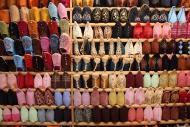We walk towards the gare routiere, and invariably we are involved in the confusion pre-departure. As soon as we cross the threshold of the station, a swarm of young men in leather jackets, beggars, barefoot children and alleged long-time travelers gets around us. The cries are more and more lively and playful, then become nervous indicating a certain dissatisfaction with the deal which does not go on smoothly. In a few seconds, upon pronouncing the magic word (Ouarzazate), we find ourselves gently pushed towards a rickety bus, decked out in a multitude of gold and red colored ribbons and spangles. We finally felt at home. Now starts the bargaining for the price and the best seats. 30, 25, 20, the price goes down and down the claims: back seats of the bus and seats upholstered in dusty hair sheep.
We walk towards the bus station, and we are inevitably involved in the pre-departure hustle… finally the bus leaves, towards the desert, but we must now face the Atlas: dense pine forests, extensive golden wheat crops and quiet Berber villages, a brief stop in Taddert for lunch. We overcome the Tizi’n Tichka (2500 meters of altitude), which in Tamazight language means “pass of the pastures”. The hot and dry air announces the desert, the Sahara. In the journey, we meet Brahim, a sympathetic Moroccan who works in Bergamo; with him we make the first steps in the more authentic Morocco. He invites us to his cousin’s house when we arrive at Ouarzazate, we talk and he gives us something to eat, we understand that there is much to share and the possibility of establishing a truly warm relationship. We spend a pleasant day with Brahim and the three brothers (Lahcen is the only one who understands English), it is a pity not to speak French, but we can understand each other with Spanish and we try to learn the first words in Arabic (Shukran, naan/la, inshallah, salam/salem). They continue to offer their hospitality, in form of mint tea, pleasant chats and delicious snacks. We understand that mutual curiosity is not always enough to brake the cultural “wall” that separates us: we cannot merge our relativism with their way of thinking linked to Muslim culture. Even from children, lives of men and women are separated. For men it is given the privilege of choice, while for women the fate will always be indelibly marked by the teachings of the mother and the wish of the father and then of the husband.
During the night, upon having enjoyed a delicious tajine of lamb cooked with our new friends, we make a long trek up to the casbah of Taourirt, all together. The full moon creates a dream, it seems to animate the casbah and relive the times of its glory, when it was one of the residences of Glaoui, the pacha of Marrakech. Ourzazate, which is located where the Valleys of Draa and Dades meet, introduces to the first seeings of the Sahara Desert. The city is quite modern (it was founded by the French in the 20s), and it is still a place of transit along the routes of traders and tourists that, from Marrakech, lead to the desert borders of Zagora and Merzouga. The climate is tempered by its altitude which exceeds 1.100 meters.
Travel tip: sit down in a bar of the city center to enjoy a tasteful mint tea, skillfully served from the teapot, in order to release all its flavour.


